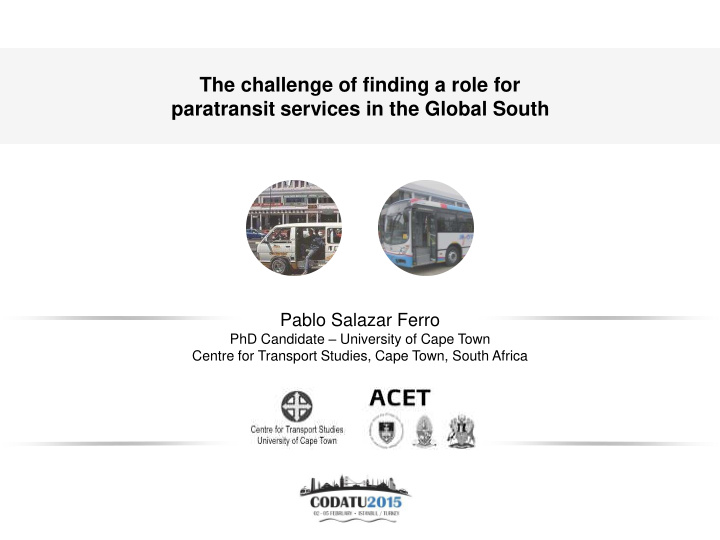



The challenge of finding a role for paratransit services in the Global South Pablo Salazar Ferro PhD Candidate – University of Cape Town Centre for Transport Studies, Cape Town, South Africa
Definition of paratransit services 1 Paratransit services Formal services Transport collectif artisanal Transport institutionnel Informal / Illegal transport Planned transport 2 Importance of paratransit services Sub-Saharan Africa Mediterranean Region Latin America Accra Alexandria Caracas 90% 59% 53% 2008 2014 2007 Cape Town Casablanca Lima 44% 44% 90% 2013 2008 2005 Dar es Salaam Tunis Sao Paulo 97% 0% 0% 2006 2013 2012 - 2 -
Transforming paratransit services using BRT-type systems 3 A myriad of approaches: from radical changes to progressive evolution of operators Citywide gradual services’ Citywide (relatively immediate) Progressive corridor-by-corridor transformation implementation reorganisation Quito, Accra, 2006 (on-going) Quito, Cape Town, Dakar, 2002 2012 2000 approaches to paratransit reform Bogota, Lagos, 2000 2008 Increasingly more forceful Curitiba, 1970s Santiago, 2007 Quito, 1995 - 3 -
Example 1: Santiago 4 2007 Santiago, Not allowed on proposed Chile BRT trunk routes OPTION 1: Formalise and become feeder operators Utilise experience to participate in feeder route OPTION 2: design Withdraw from Loss of paratransit-like Formalisation the system benefits in some areas Disappearance Only marginally included Limited transformation Maintain paratransit-like characteristics: Flexibility No changes Demand responsiveness - 4 -
Example 2: Bogota 4 2000 Bogota, Creation of trunk companies For each new corridor: Colombia Affected operators were either and feeder companies included, either marginalised from reform initiatives OPTION 1: Selected operators Participate in BRT operations OPTION 2: Withdraw from the corridor Withdraw to other transport axes in the city but maintain high coverage No changes in unregulated environment - 5 -
Example 3: Dakar 4 2000 Dakar, Fleet renewal project: Senegal Fleet renewal initiative that also Improved efficiency (vehicles) included the introduction of new - but - regulatory measures to the system Regulation still weak Renewed services Limited inclusion Unchanged services Unregulated services providing required services Not included in the current reform initiative Services are competitive in the current context, but officials consider them a No changes problematic element of the system - 6 -
Conclusions 5 The challenge of finding a role for paratransit services Flexibility Fragmentation / Atomisation Demand responsiveness Disorganisation Loss of advantages in An acknowledged the urban context need to reform Trade-off between operational advantages of formalisation and loss of paratransit-like benefits (coverage, flexibility) - 7 -
Conclusions 5 The challenge of finding a role for paratransit services Relatively less expensive for authorities Climate change concerns Resistant to environmental concerns Energy efficiency concerns Loss of advantages in An acknowledged the urban context need to reform Need for operational complementarity between formal and paratransit services - 8 -
Recommend
More recommend